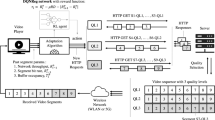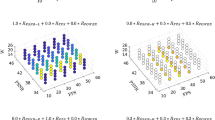Abstract
With the increasing popularity of various video services, video content is becoming a dominant traffic type in mobile networks. This poses a serious challenge to mobile network operators as well as service providers when it comes to delivering video content in a controllable and resource-efficient way to multiple users. Meeting various quality of experience and quality of service requirements is a difficult task especially in a wireless environment where several different priority based user classes can be included. This paper proposes an intelligent and context-aware application level fair scheduler, which is based on reinforcement learning and which can dynamically adjust relevant scheduling parameters in reaction to specific events or context information. The implemented Q-learning method is analyzed with reference to the delivery of progressive video streaming services employed by the likes of YouTube, Daily Motion, etc. In this regard, we study the performance observed by the end users in a scenario where the backhaul link in a mobile network infrastructure may become congested. Using the application level scheduler to intelligently orchestrate between multiple concurrent flows will minimize the number of buffer starvation events and thus enable smooth playback in cases where a pure TCP based delivery would fail. We also demonstrate the effectiveness of the Q-learning based scheduler to provide service separation between the user classes and fairness within a user class.























Similar content being viewed by others
References
Alcock, S., & Nelson, R. (2011). Application flow control in YouTube video streams. SIGCOMM Computer Communications Review, 41(2), 24–30.
Bertsekas, D. (2007). Dynamic programming and optimal control, vol. 1&2. Belmont, MA: Athena Scientific.
Changuel, N., Sayadi, B., & Kieffer, M. (2012). Online learning for QoE-based video streaming to mobile receivers. In Proceedings of the 2012 IEEE globecom workshops (GC Wkshps), pp. 1319–1324.
Cisco Visual Networking Index: Global mobile data traffic forecast Update, 2011–2016 (2013). http://www.puremobile.com/media/infortis/documents/cisco_mobile_forecast.pdf
Ghobadi, M., Cheng, Y., Jain, A., & Mathis, M. (2012). Trickle: Rate limiting youtube video streaming. In Proceedings of the 2012 USENIX conference on annual technical conference, USENIX ATC’12 (pp. 17–17). USENIX Association, Berkeley, CA, USA. http://dl.acm.org/citation.cfm?id=2342821.2342838
Habachi, O., Hu, Y., Van der Schaar, M., Hayel, Y., & Wu, F. (2012). QoE-aware congestion control algorithm for conversational services. In Proceedings of the 2012 IEEE international conference on communications (ICC), pp. 5233–5537.
Hoen, P. J., Tuyls, K., Panait, L., Luke, S., & La Poutré, J. A. (2006). An overview of cooperative and competitive multiagent learning. In K. Tuyls, P. J. Hoen, K. Verbeeck, S. Sen (Eds.) Proceedings of the first international on learning and adaption in multi-agent systems (LAMAS 2005), Lecture Notes in Computer Science, Vol. 3898, pp. 1–46. Springer.
INET Framework for OMNeT++: (2013). http://inet.omnetpp.org
Kaelbling, L. P., Littman, M. L., & Moore, A. W. (1996). Reinforcement learning: A survey. Journal of Artificial Intelligence Research, 4, 237–285.
Lederer, S., Mueller, C., & Timmerer, C. (2012). Dynamic adaptive streaming over http dataset. In Proceedings of the ACM multimedia systems conference, Chapel Hill, NC, USA.
Maier, G., Feldmann, A., Paxson, V., & Allman, M. (2009). On dominant characteristics of residential broadband internet traffic. In Proceedings of the 9th ACM SIGCOMM conference on internet measurement conference, IMC ’09, pp. 90–102.
Matos, R., Coutinho, N., Marques, C., Sargento, S., Chakareski, J., & Kassler, A. (2012). Quality of experience-based routing in multi-service wireless mesh networks. In Proceedings of the 2012 IEEE international conference on communications (ICC), pp. 7060–7065.
Navarro-Ortiz, J., Ameigeiras, P., Lopez-Soler, J., Lorca-Hernando, J., Perez-Tarrero, Q., & Garcia-Perez, R. (2013). A QoE-aware scheduler for http progressive video in OFDMA systems. IEEE Communications Letters, 17(4), 677–680.
Satoda, K., Yoshida, H., Ito, H., & Ozawa, K. (2012). Adaptive video pacing method based on the prediction of stochastic tcp throughput. In Global communications conference (GLOBECOM), 2012 IEEE, pp. 1944–1950.
Sutton, R., & Barto, A. (1998). Reinforcement learning: An introduction. Cambridge: MIT Press.
Tran, H. A., Mellouk, A., Hoceini, S., & Augustin, B. (2012). Global state-dependent qoe based routing. In Proceedings of the 2012 IEEE international conference on communications (ICC), pp. 131–135.
Tran, H. A., Mellouk, A., Hoceini, S., & Souihi, S. (2012). User QoE-based adaptive routing system for future internet cdn. In Proceedings of the 2012 computing, communications and applications conference (ComComAp), pp. 90–95.
Watkins, C. (1989). Learning from delayed eewards. Ph.D. thesis, Cambridge University, Cambridge.
Yousaf, F. Z., Liebsch, M., Maeder, A., & Schmid, S. (2013). Mobile CDN enhancements for QoE-improved content delivery in mobile operator networks. IEEE Network Magazine (Special Issue on Video Over Mobile Networks), 27(2), 14–21.
Yousaf, F. Z., Mämmelä, O., & Mannersalo, P. (2014). Reinforcement learning method for QoE-aware optimization of content delivery. In IEEE wireless communications and networking conference (WCNC), pp. 1–6.
Acknowledgments
This research has been performed within the UniverSelf Project (www.univerself-project.eu) and received funding from the European Community’s Seventh Framework Programme (FP7/ 2007-2013) under Grant Agreement No. 257513. The work by Mannersalo and Mämmelä was also supported by the Finnish Funding Agency for Technology and Innovation (Tekes) in the framework of the EUREKA/Celtic COMMUNE.
Author information
Authors and Affiliations
Corresponding author
Rights and permissions
About this article
Cite this article
Mämmelä, O., Yousaf, F.Z., Mannersalo, P. et al. Policy-Based and QoE-Aware Content Delivery Using Q-Learning Method. Wireless Pers Commun 83, 315–342 (2015). https://doi.org/10.1007/s11277-015-2395-1
Published:
Issue Date:
DOI: https://doi.org/10.1007/s11277-015-2395-1




